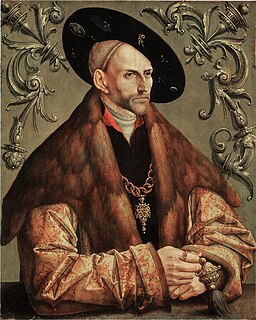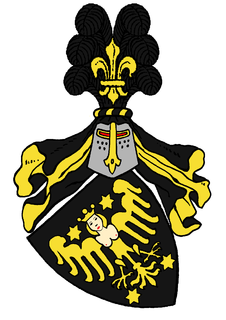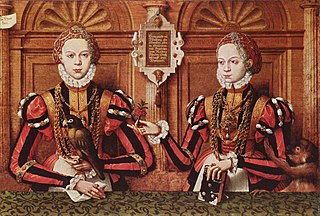Werner V was a Rhenish Franconian count in the Nahegau, Speyergau and Wormsgau. He is one of the earliest documented ancestors of the Salian dynasty that provided German kings and emperors of the Holy Roman Empire from 1024 to 1125.
Margaret of Baux was a Countess of Saint-Pol, of Brienne, and of Conversano. She was a member of the noble House of Baux of the Kingdom of Naples, which had its origins in Provence dating back to the 11th century. Her husband was Peter of Luxembourg, Count of Saint-Pol, of Brienne, and of Conversano. Margaret's descendants include English Queen Consort Elizabeth Woodville, King Henry IV of France, Mary, Queen of Scots, and all English monarchs after 1509.

Adolf van Nieuwenaar, Count of Limburg and Moers was a statesman and soldier, who was stadtholder of Overijssel, Guelders and Utrecht for the States-General of the Netherlands during the Eighty Years' War.

Edzard I, also Edzard the Great was count of East Frisia from 1491 till his death in 1528.

The Cirksena are a noble East Frisian family descended from a line of East Frisian chieftains from Greetsiel.
Dorothea of Brandenburg was a princess of Brandenburg by birth and by marriage Duchess of Saxe-Lauenburg.

Countess Armgard of Rietberg was from 1562 to 1584 Countess of Rietberg in her own right. She was also Countess of Hoya by marriage from 1568 to 1575 and Countess of Lippe by marriage from 1578 until her death.
Gerberga of Burgundy was a member of the Elder House of Welf. She was married firstly to Herman I, count of Werl and secondly to Herman II, Duke of Swabia.
Count Otto III Rietberg was Count of Rietberg from 1516 to 1535.
Count John Louis of Nassau-Saarbrücken was the posthumous son of Count John II and his second wife, Elisabeth of Württemberg-Urach.
Otto IV, Count of Waldeck at Landau was the third and last ruling count of the elder Waldeck-Landau line. He was the grandson of Count Adolph III, who had founded the elder Waldeck-Landau line in 1387 and was the third and only surviving son of Count Otto III and his wife Anna of Oldenburg. His elder brothers John and Henry had died unmarried and childless in 1431 and 1438 respectively.
Count John I of Rietberg was Count of Rietberg from 1472 until his death. He was the eldest son of Count Conrad V and his wife Jacoba of Neuenahr. When his father died in 1472, he inherited the County of Rietberg.
Conrad IV, Count of Rietberg was Count of Rietberg from 1389 until his death.

Arnold III of Bentheim-Tecklenburg-Steinfurt-Limburg was a German nobleman. He was Count of Bentheim, Tecklenburg and Steinfurt, and jure uxoris Count of Limburg. He ruled as Arnold IV in Bentheim and Tecklenburg, and as Arnold II in Steinfurt. In Limburg, he was the first Count named Arnold and hence just the name distinctive.
Otto II, Count of Rietberg was the ruling Count of Rietberg from 1365 until his death.
Gumprecht II of Neuenahr was a German nobleman. He inherited the County of Limburg via his wife.
Magdalena of Neuenahr-Alpen was a German noblewoman. She was the heiress of the House of Neuenahr-Alpen; she inherited the County of Limburg. By marriage, she was Countess of Tecklenburg.
Count Berengar II of Sulzbach, sometimes known as Berengar I of Sulzbach, was Count of Sulzbach in Bavaria. Berengar was a leader of the reform party. He sided with Pope Gregory VII during the Investiture Controversy in opposition to Henry IV, Holy Roman Emperor, and supported Henry V in his successful rebellion against his father. He is known as the founder of several abbeys.

Count Maximilian Ulrich von Kaunitz-Rietberg was an Austrian diplomat, politician and also a Governor of Moravia from 1720 to 1746. His older brother was Franz Karl von Kaunitz (1676–1717), a canon in Olomouc and Bishop of Ljubljana (Laibach).
Adelaide of Lauffen was a German noblewoman of the eleventh and twelfth centuries.






